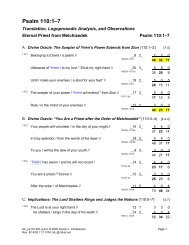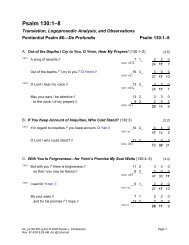Reading Genesis 1-2 in Hebrew - Bibal.Net
Reading Genesis 1-2 in Hebrew - Bibal.Net
Reading Genesis 1-2 in Hebrew - Bibal.Net
You also want an ePaper? Increase the reach of your titles
YUMPU automatically turns print PDFs into web optimized ePapers that Google loves.
<strong>Read<strong>in</strong>g</strong> <strong>Genesis</strong> 1–2 <strong>in</strong> <strong>Hebrew</strong><br />
√������������œ������‹<br />
����������������������������������œ•���1:24�<br />
�����‘������•��√������������„<br />
��‘��������������ı������û�����������<br />
√������������œ������‹<br />
����������������������������������œ•��—transliteration:<br />
way-yOµ'-mer 'È-lO-hÓµm TÙ-cEµ'<br />
hA-'Aµ-rec neµ-peH xay-y‰µ l¸-mÓ-nAµh, “and Elohim said, ‘Let the earth br<strong>in</strong>g forth liv<strong>in</strong>g creatures<br />
after their k<strong>in</strong>d.’” On the first two words, see 1:20 above. The verb ����� is Hiphil (causative)<br />
imperfect 3 rd sg. fem. from the root 'cy (“go forth”) used as a jussive, with ����<br />
���� (“the land”).as<br />
subject. On the construct cha<strong>in</strong> ��œ������‹ �� (“liv<strong>in</strong>g creatures”) see 1:21. The word √��������<br />
(“to her<br />
k<strong>in</strong>d”) is the comb<strong>in</strong>ation of the preposition l (“to, after”) + the noun §yim (“k<strong>in</strong>d”) + the 3 rd sg.<br />
fem. pronom<strong>in</strong>al suffix –hAñ. The dot (daghesh) here is the hE maPPÓq, which <strong>in</strong>dicates that it<br />
carries consonantal force. Without the dot, a f<strong>in</strong>al hE is silent (i.e., used as a vowel letter).<br />
�����‘������•��√������������„<br />
��‘��������������ı������û������—transliteration:<br />
B¸-hE-m‰µ wA-reµ-meW w¸-ha-y¸-tÙ-<br />
'eµ-rec l¸-mÓ-nAµh wa-y¸-hÓ-kEµn, “herd-animals and crawl<strong>in</strong>g th<strong>in</strong>gs and wildlife of the earth after<br />
their k<strong>in</strong>d, and it was so.” The fem. noun hAmEh–¯b, which is commonly translated as “cattle,” is a<br />
more general term that refers to liv<strong>in</strong>g creatures other than humans, <strong>in</strong>clud<strong>in</strong>g all the larger<br />
animals. Here it is used <strong>in</strong> opposition to wild “animals of the earth” (ere'-Ùt¯yax) and is thus<br />
<strong>in</strong>terpreted to mean domestic or perhaps “herd-animals” like cattle, sheep and goats (i.e.,<br />
livestock).” The segholate noun Wemer (“creep<strong>in</strong>g th<strong>in</strong>gs”), which is used <strong>in</strong> a collective sense, is<br />
prefixed with the wau-conjunction. On the expression ����‘������•�, see 1:11, 15 above.<br />
�√��������������������•œ��‘������������������•œ•���1:25�<br />
√������������������‘����������<br />
�����‘��ƒ���„ ���������û•œ•�������������„<br />
��������������û��‘��ƒ��ô���������<br />
√��������������������•œ��‘������������������•œ•��—transliteration:<br />
way-yaµ-vaW 'È-lO-hÓµm 'et-xay-yaµt<br />
hA-'Aµ-rec l¸-mÓ-nAµh, “and Elohim made the wildlife of the earth after their k<strong>in</strong>d.” The verb here is<br />
Qal shortened imperfect 3 rd sg. masc. with wau-conversive from the root hWv (“make, do”) with<br />
Elohim as subject. The direct object of the verb is the s<strong>in</strong>gular nom<strong>in</strong>al phrase erA'Ah t¬Cyax (“liv<strong>in</strong>g<br />
creature of the earth”) used <strong>in</strong> a collective sense. On –hƒnyimÕl see 1:11, 15, 24.<br />
√������������������‘�����—transliteration:<br />
w¸-'et-haB-B¸-hE-m‰µ l¸-mÓ-nAµh, “and herd-animals (or<br />
livestock) after their k<strong>in</strong>d.” On the mean<strong>in</strong>g of the words here, see 1:24.<br />
�����������„<br />
��������������û��‘��ƒ��ô����—transliteration:<br />
w¸-'Eµt Kol-reµ-meW hA-'·-dA-m‰µ l¸-mÓ-nEµ-h˚, “and<br />
everyth<strong>in</strong>g that creeps on the ground, after its k<strong>in</strong>d.” The masc. collective noun Wemerµ (“creep<strong>in</strong>g<br />
th<strong>in</strong>gs”) is another example of what is often called a segolate noun, with the stress on the<br />
© 2005 BIBAL Corporation, All Rights Reserved Version 1.0<br />
16





